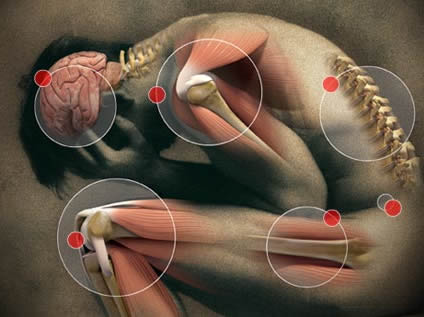There are many varieties and types of chronic pain
One of the first steps in diagnosing chronic pain and and different types of chronic pain issues is understanding the various of types of pain one can experience. This article will explore the different types of chronic pain the human body can experience.
General somatic pain (pain from the outer body)
- Pains from your skin and muscles are easily localized by the brain because these pains are common. You have experienced general somatic pain since childhood when you have fallen or been hit by a person or an object. Normally, somatic pain gets better in a few days.
- Some people develop pain that never goes away. Fibromyalgia and chronic back pain are in this category.
- General somatic pain is often treated with nonsteroidal anti-inflammatory drugs (NSAIDs) such as ibuprofen (Motrin) or naproxen (Naprosyn) or with acetaminophen (Tylenol). Sometimes, opioids, such as morphine, may be needed.
Visceral pain (pain from the internal organs)
- Pain in your internal organs is more difficult for you to pinpoint because your brain doesn’t get much experience feeling pain from internal organs. The connections from pain sensors in your internal organs to your brain are less sophisticated than the nerve connections from your outer body.
- You have experienced some visceral pains. Pain from acid indigestion or constipation is easy to recognize. These pains are easily treated and get better quickly either on their own or with treatment using nonprescription medicines.
- But the pain from chronic pancreatitis (an inflammation of the pancreas) or chronic active hepatitis (an inflammation of the liver) can last a long time and be difficult to treat.
- Visceral pain from gallstones or appendicitis, for example, can be treated with surgery. Other visceral pains can be treated with various non-opioid pain medications. Sometimes opioids may be needed.
Bone pain
- Pain in the bones from a bruise or a fracture is temporary. Pain from bone cancer, osteoporosis (softening of the bones that often appears in older people), osteomyelitis (an infection in a bone), or arthritis (inflammation of the joints) can last a long time.
- Bone pain is gnawing and throbbing. If you suffer from this, you may need long-term pain treatment. Bone pain may be treated with hormonal therapy or with bisphosphonates, such as alendronate (Fosamax), which strengthen the bones. Often, the NSAIDs (such as ibuprofen) are used. Sometimes opioids are needed.
Muscle spasm (muscle cramps)
- Muscle spasm, like a charley horse, can cause severe pain especially in the back. Pain medication alone may not be able to cure the pain. Muscle relaxants such as cyclobenzaprine (Flexeril) or baclofen (Lioresal) may be needed to relax the muscles.
Peripheral neuropathy (pain arising in the nerves leading from the head, face, trunk, or extremities to the spinal cord)
- In a sense, all pain comes from nerves because nerves transmit painful impulses to the brain. But some painful impulses do not arise from the nerve endings that normally sense injury or illness. Some painful impulses come from irritation to the nerve along its length instead of at the nerve ending.
- Sciatica, for example, is caused by pinching of the sciatic nerve, which goes from the leg to the spine. The pinching often takes place near the lower part of the spine, but the brain “thinks” the pain came from the nerve endings in the leg because the sciatic nerve usually transmits feelings from the leg.
- Other examples of illnesses that cause peripheral neuropathy or “nerve pain” are ruptured discs in the spine, which pinch nerves, cancers that grow into nerves and cause irritation, or infections, such as shingles, which can cause irritation to nerves.
- Common diseases that often cause peripheral neuropathy are diabetes and AIDS.
- Nerve pain can feel like a painful “pins and needles” sensation. This kind of nerve pain can be treated with tricyclic antidepressants. Other, more severe nerve pain can be described as a sharp, stabbing, electric feeling. Anticonvulsants (medicines that treat seizures) are used for this kind of nerve pain.
- Some nerve pain is due to loss of a limb. The arm or leg that has been lost feels like it’s still present, and hurts severely. This kind of nerve pain, called deafferentation, or “phantom limb pain,” can be treated with clonidine (Catapres) (a blood pressure medicine that also relieves nerve pain).
- Herpes zoster (shingles) causes an infection of the nerve endings and of the skin near the nerve endings. Local application of capsaicin (Zostrix), an over-the-counter pain medication in the form of an ointment, is sometimes helpful for this. In addition, opioids may be needed.
Circulatory problems
- Poor circulation is often a cause of chronic pain. Poor circulation is usually caused by tobacco use, diabetes, or various autoimmune diseases (diseases where the body makes antibodies that fight against itself) such as lupus or rheumatoid arthritis.
- Partial blockage of arteries by fatty deposits called plaques is also a common cause of poor circulation. The reason for the pain of poor circulation is that the part of the body that does not get good blood circulation becomes short of oxygen and nourishment. The lack of oxygen and nutrition causes damage to that part of the body, and the damage causes pain.
- Pain from poor circulation may be treated by surgery to bypass the clogged arteries with artificial arteries in order to improve the blood circulation. Sometimes this is not possible, and blood thinners or opioids may be needed to control the pain.
- Another common cause of poor circulation is reflex sympathetic dystrophy (RSD). This is a problem of both circulation and nerve transmission because painful nerve transmissions cause the blood vessels to get narrower. The narrowing prevents enough oxygen and nourishment from getting to the part of the body that is affected. RSD can sometimes be treated with a surgical sympathectomy, an operation to stop the nerve impulses from causing a narrowing of the blood vessels. Often, non-opioid medication, either with or without surgery, is needed. Sometimes opioids are needed.
Headaches
- Headaches can be caused by many illnesses. There are several types of headaches, including migraine, tension, and cluster headaches. Headaches can also result from sinusitis, trigeminal neuralgia, giant cell arteritis, or brain tumors. The treatment of the various kinds of headaches varies depending on the kind of headache and the severity of the pain. Often, non-opioid medicines are used. But, in some cases, opioid therapy is needed.
- Migraines are often on one side of the head. They can be associated with nausea and vomiting, photophobia (light hurting the eyes), phonophobia (sound hurting the ears), and scintillating scotomata (parallel lines that vibrate at the edges of objects, especially at the borders between light and dark places). Sometimes these auras appear before the headache starts and alert you that a migraine is coming. Migraine pain can vary in intensity from mild to severe. There are many specific medications for migraine. Sumatriptan (Imitrex) is particularly useful for some, but not all, migraine sufferers.
- Cluster headaches come in groups, sometimes several times a day, lasting for days to weeks. Many cluster headaches are severely painful. Oxygen therapy may be helpful for some cluster headaches.
- Sinusitis can cause facial pain and is frequently worse in the morning. Sinus pain may respond to antibiotic treatment along with decongestants. Sometimes sinus surgery is needed.
- Trigeminal neuralgia is actually a peripheral neuropathy (nerve pain) that is severe. It occurs on one side of the head and face and has a “trigger point,” usually on the side of the face, which causes intense pain if it is touched. Anticonvulsants (antiseizure medicine) are often helpful for this type of pain.
Do you suffer from one of these types of chronic pain? Leave a comment below on the type of pain you suffer from and perhaps others can relate and be a support.






Recent Comments